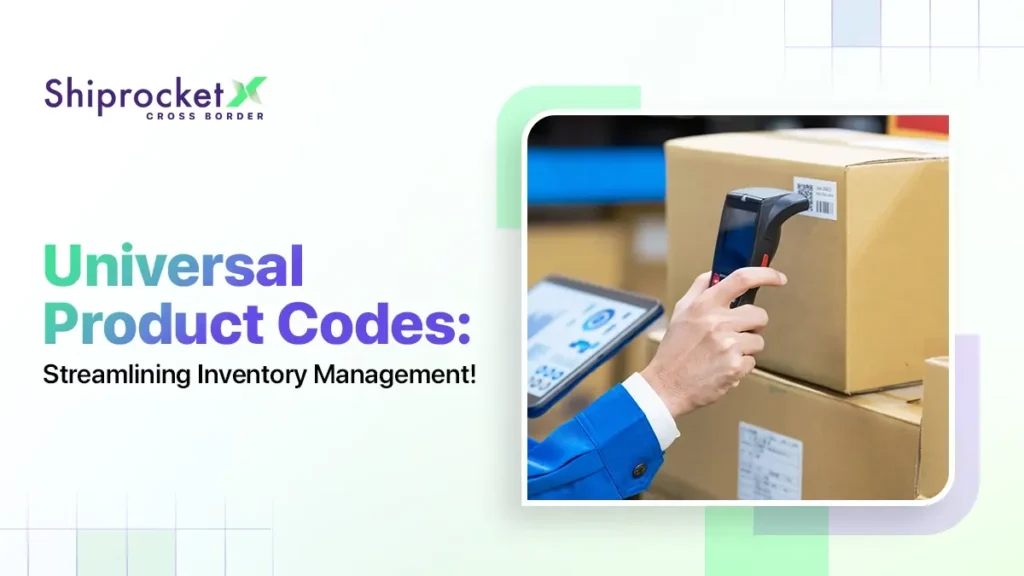What Does Universal Product Code Mean in Export Business?
- Universal Product Code: A Brief Description
- Why is a Universal Product Code Advantageous?
- Components of Universal Product Code
- A Comparison Between Universal Product Code and Other Product Codes
- Obtaining a Universal Product Code for Your Product: Stepwise Guide
- Why is it Necessary to Have a Universal Product Code?
- Conclusion
The barcodes on your everyday stuff are usually called Universal Product Codes (UPCs). These are known globally and help keep track of products when you buy them or move them around in the export business. Even though you see them often, you might not have realised how useful they are.
Here’s the deal: UPC barcodes are a big deal, especially for small businesses. They can make things run smoother and help businesses make more money. These codes help determine where products come from, track how many are left, speed up the checkout process, and give important info about sales.

Universal Product Code: A Brief Description
A UPC, or Universal Product Code, is like a unique ID for products. It’s the barcode you often see on items at the store. The barcode comprises black lines of different thicknesses, and these lines hold a unique number called a GTIN. This number helps the store’s computer know which product you’re buying.
There are different types of UPCs. The most common one is UPC-A, which is found in in-store products. There are also others, like:
- GS1 DataBar: Used for produce, coupons, and fresh items. It contains extra information like the expiry date.
- ITF-14: Barcode for boxes and materials in warehouses; identifies cartons, pallets, and cases
- GS1-128: Barcode with GTIN and additional product information, such as expiration dates
- QR Codes: Two-dimensional barcodes with squares that link to online information about the product, scanned with phones.
Why is a Universal Product Code Advantageous?
A Universal Product Code (UPC) offers numerous advantages for businesses:
- Speeds up Checkout Process: When you scan items with a barcode reader at the store, UPCs make things faster. You don’t have to type in details; the billing happens quickly, so you wait less.
- Helps with Inventory: UPCs are like helpers for tracking how much stuff is in the store and what’s selling where. They ensure things are where they should be, reducing mistakes and saving time.
- Ensures Order Accuracy: When your orders are packed, UPCs help ensure you get the right stuff.
- Enables Product Recalls: If something is wrong with a product, stores can find out quickly using UPCs. This helps them recall only the bad stuff.
- Saves You Time: Imagine waiting in line at the store while the cashier manually types in every product. With UPCs, scanning is quick, so you spend less time in line.
- Organises Inventory Better: UPCs help stores know what’s in stock and where it is. This means they can find things faster, making your shopping experience smoother.
- Costs Less for Businesses: Getting UPCs for products isn’t expensive for stores. They can customise them based on needs and budgets, and it’s a wise investment for their business.
- Keeps Things Accurate: Even the best workers might make a mistake, but with UPCs, things stay accurate, making your shopping trips more reliable.
Components of Universal Product Code
Every product requires its unique UPC, and these barcodes can serve different purposes based on the data they contain. Each difference may warrant a separate UPC, whether it’s size, colour, or package size change. The UPC label itself consists of two main parts: the barcode and a 12-digit number below it, known as the Global Trade Item Number (GTIN).
- Barcode: Visual representation with black lines and white spaces
- Number: 12-digit GTIN, critical for product identification.
The GTIN, encoded within the barcode, is crucial for identifying and validating a product. This 12-digit code can be broken down into three essential components, each serving a specific role in ensuring accurate tracking and management:
- Manufacturer Identification Number
The Manufacturer Identification Number is the first component, consisting of a unique 6-digit code at the beginning of the UPC. This number plays a vital role in identifying the manufacturer of the product. It remains consistent across all products produced by the same company, providing a standardised way to recognise the origin of each item.
- Item Number
Following the manufacturer identification number is the item number, composed of the subsequent five digits. This portion of the GTIN serves to identify each product variant uniquely. For instance, it helps differentiate between different versions of the same product, such as distinguishing between various smartphone storage capacities.
- Check Digit
The third and final component is the Check Digit, which is found at the end of the 12-digit UPC. This digit is calculated using the other numbers in the code. It is crucial during scanning at the Point of Sale (POS). By validating the accuracy of the UPC, Check Digit helps prevent scanning errors, contributing to reliable inventory management systems. It ensures the product information is correctly captured, adding precision to the overall identification process.
A Comparison Between Universal Product Code and Other Product Codes
In retail, SKUs, UPCs, EANs, ASINs, and barcodes are essential tools for effective inventory management, standardised tracking, and cross-platform compatibility.
The Universal Product Code (UPC) is a unique 12-digit numerical code with a barcode assigned to a product. It is regulated by the international organisation GS1. UPCs provide a standardised product identification system globally, ensuring consistent tracking throughout the supply chain.
- SKU (Stock Keeping Unit):
SKU (Stock Keeping Unit) is an alphanumeric code merchants create for each product, typically composed of 8-10 letters and numbers. SKUs serve as internal identifiers, facilitating efficient inventory management and tracking. They are customisable and reflect unique product features, allowing businesses to adapt their SKU system based on internal rules.
- EAN (European Article Number):
The European Article Number (EAN) is a 13-digit product identifier commonly used in Europe. Despite a historical compatibility issue with some US point-of-sale systems, modern scanners can now read both EAN and UPC barcodes.
- ASIN (Amazon Standard Identification Number):
ASIN (Amazon Standard Identification Number) is an exclusive identifier for Amazon, often derived from a product’s UPC barcode. ASIN streamlines product management within the Amazon ecosystem, providing a distinctive identification system.
- Barcodes:
Barcodes are machine-readable images consisting of parallel black-and-white lines. Used for product identification, UPCs always include unique barcodes crucial for scanning and universal product recognition. Barcodes visually represent SKU or UPC numeric codes, enhancing efficient inventory management with barcode scanners.
Obtaining a Universal Product Code for Your Product: Stepwise Guide
- Step 1:
Visit the GS1 Website: Start by going to the GS1 website’s barcode application section.
- Step 2:
Determine Your Needs: Estimate the number of UPC barcodes required based on your unique products, considering variations in size, colour, and other attributes. Remember, each product variant needs its own UPC.
- Step 3:
Choose the Right Option: GS1 provides different ways to purchase UPCs. You can buy individual GTINs for a few products or opt for a GS1 company prefix. If you have multiple products or anticipate future additions, a company prefix allows you to generate GTINs with consistent manufacturer identification numbers, aiding in product tracking.
- Step 4:
Provide Information and Pay: Fill in your contact details and proceed to the payment step. Once the payment is processed, GS1 will provide you with your unique UPCs. It’s essential to note that UPCs must be purchased from GS1 to ensure their uniqueness and validity.
Creating your own UPC is not allowed. Purchasing from GS1 ensures that each code is unique, valid, and follows international standards, making it a crucial step for product identification and tracking.
Why is it Necessary to Have a Universal Product Code?
Creating UPC barcodes is crucial for export businesses planning to sell products on platforms like Amazon or through brick-and-mortar stores. Major retailers, including Amazon, require unique ID codes, making UPCs the widely accepted standard for product identification and access to various sales channels. UPCs enable accurate tracking of stock levels throughout the entire supply chain, from production to sale, encompassing third-party logistics and shipping companies.
Even if not currently required, adding a UPC to product packaging can open doors to more sales channels, providing access to a broader audience. Standardised barcodes streamline retail operations.
Conclusion
Universal Product Codes (UPCs) have become a widely accepted method for product identification. They use a unique Global Trade Item Number in a scannable barcode to help manufacturers keep track of their stock, assist warehouses in efficient order fulfillment, and enable retail stores to process sales quickly. The impact of UPCs on business automation is significant, providing lasting contributions to the straightforward management and tracking of inventory on a global scale.
In addition to allocating business prefixes, the GS1 establishes international logistical and item barcoding guidelines. All of the guidelines for number allocation are contained in the GS1 General Specification. The GS1 standards prohibit the reuse of UPC (GTIN) as of January 2019.
GS1 US, a nonprofit organisation that establishes standards for global trade, distributes UPCs. Companies can join GS1 US for a fee, and in return, the organisation gives each member an identifying number that serves as the initial portion of their UPC.
Price and the item’s PLU (price look-up) code are encoded into price-embedded barcodes, sometimes referred to as random weight, variable price, or type 2 UPC-A barcodes. If a product’s measure varies anywhere along the supply chain, it qualifies as a variable measure commerce item.





